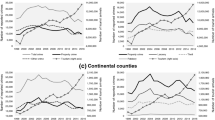Abstract
Using a panel data set of European countries, this paper investigates the impact of crime on international tourism. Violent crimes are negatively associated with incoming international tourists and international tourism revenue indicating that international tourists consider the risk of victimization when choosing a location to visit. This impact is smaller in magnitude in Southern European countries with a coastline which are generally more attractive tourist destinations in terms of sea tourism, suggesting that victimization risk and attractiveness of the destination may be substitutable traits.

Similar content being viewed by others
Notes
Regarding the impact of word-of-mouth information on behavior, see Rincke and Traxler (2009).
This holds true even for the violent crimes. Some violent crimes, such as robberies, involve monetary returns. In addition, violent crimes may occur due to a property crime. For example, a pocket lifter may use their weapon to force the victim to surrender, if the victim notices their wallet/purse is being stolen.
These authors do not find a relationship between tourism activity and violent crime. This may be because, when tourists (who are presumably wealthy) visit a country, the expected return to criminal activities such as theft and burglary goes up, since incoming tourists may increase the number of targets from whom valuable assets can be stolen by the potential criminals. However, there are no direct incentives for committing a violent crime, such as murder or rape. Therefore, the link from tourism to violent crime is expected to be much weaker.
Specifically, these authors use one period lagged arrest rates to explain the variation in crime.
Russia is an exception. This is because, the majority of Russian territory is located in the Northern Europe where the climate does not permit sea tourism.
Russia is an exception. I excluded Russia from the Sea Tourism Available sample, because the majority of Russian territory is located in Northern Europe where the weather conditions are not suitable for sea tourism.
Although the coefficient of the homicide rate in the No Sea Tourism Opportunity sample is much larger than it is in the Sea Tourism Available sample, the mean of tourism revenue in the No Sea Tourism sample is larger as well. In addition, the mean of the homicide rate in the No Sea Tourism sample is smaller. As a result, the elasticity estimates are comparable.
References
Balaguer J, Cantavella-Jorda M (2002) Tourism as a long-run economic growth factor: the Spanish case. Appl Econ 34:877–884
Block M, Heineke J (1975) A labor theoretic analysis of the criminal choice. Am Econ Rev 65(3):314–325
Corman H, Mocan N (2000) A time-series analysis of crime, deterrence and drug abuse in New York City. Am Econ Rev 90(3):584–604
Cullen J, Levitt S (1999) Crime, urban flight, and the consequences for cities. Rev Econ Stat 81(2):159–169
Eugenio-Martin J, Campos-Soria J (2011) Income and the substitution pattern between domestic and international tourism demand. Appl Econ 43:2519–2531
Fama E, MacBeth J (1973) Risk, return, and equilibrium: empirical tests. J Pol Econ 81(3):607–636
Feridun M (2011) Impact of terrorism on tourism in Turkey: empirical evidence from Turkey. Appl Econ 43:3349–3354
Fleischer A, Buccola S (2002) War, terror, and the tourism market in Israel. Appl Econ 34:1335–1343
Garin-Munoz T, Amaral T (2000) An econometric model for international tourism flows to Spain. Appl Econ Lett 7:525–529
Gunduz L, Hatemi JA (2005) Is the tourism-led growth hypothesis valid for Turkey? Appl Econ Lett 12:499–504
Howsen R, Jarrell S (1987) Some determinants of property crime: economic factors influence criminal behavior but cannot completely explain the syndrome. Am J Econ Sociol 4(46):445–457
Howsen R, Jarrell S (1990) Transient crowding and crime: the more “Strangers” in an area, the more crime except for murder, assault and rape. Am J Econ Sociol 4(49):483–494
Levantis T, Gani A (2000) Tourism demand and the nuisance of crime. Int J Soc Econ 27:959–967
Levitt S (1998) Juvenile crime and punishment. J Pol Econ 106:1156–1185
Lyssiotou P (2000) Dynamic analysis of British demand for tourism abroad. Empir Econ 15:421–436
Maloney W, Rojas G (2005) How elastic are sea, sand and sun? Dynamic panel estimates of the demand for tourism. Appl Econ Lett 12:277–280
McPheters L, Stronge W (1974) Crime as an environmental externality of tourism: Miami, Florida. Land Econ 50(3):288–292
Mello M, Pack A, Sinclair T (2002) A system of equations model of UK tourism demand in neighboring countries. Appl Econ 34:509–521
Patuelli R, Mussoni M, Candela G (2013) The effects of world heritage sites on domestic tourism: a spatial interaction model for Italy. J Geogr Syst 15:369–402
Peri G (2004) Socio-cultural variables and economic success: evidence from Italian provinces. B.E. J Macroecon Top 4(1), article 12.
Richardson R, Loomis J (2004) Adaptive recreation planning and climate change: a contingent visitation approach. Ecol Econ 50(1–2):83–99
Rincke J, Traxler C (2009) Deterrence through word of mouth. CESifo working paper series 2549. CESifo Group, Munich
Sequeira T, Nunes P (2008) Does tourism influence economic growth? A dynamic panel data approach. Appl Econ 40:2431–2441
Siegfried J, Zimbalist A (2000) The economics of sports facilities and their communities. J Econ Perspect 14(3):95–114
Smyth R, Nielsen I, Mishra V (2009) I’ve been to Bali too’ (and I will be going back): are terrorist shocks to Bali’s tourist arrivals permanent or transitory? Appl Econ 41:1367–1378
Vogt M (2008) Determinants of the demand for US exports and imports of tourism. Appl Econ 40:667–672
Author information
Authors and Affiliations
Corresponding author
Rights and permissions
About this article
Cite this article
Altindag, D.T. Crime and International Tourism. J Labor Res 35, 1–14 (2014). https://doi.org/10.1007/s12122-014-9174-8
Published:
Issue Date:
DOI: https://doi.org/10.1007/s12122-014-9174-8




